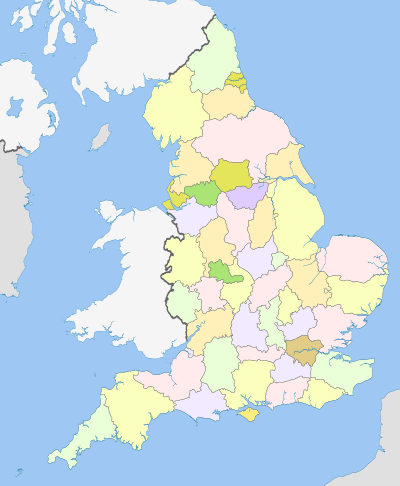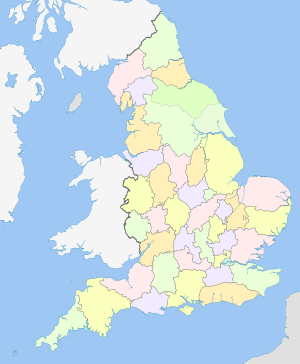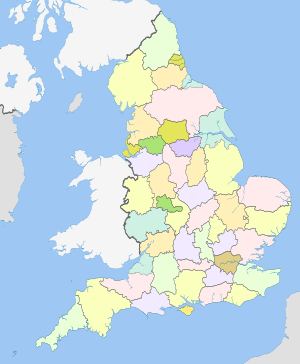Ceremonial counties of England facts for kids
Quick facts for kids Ceremonial counties of Englandand shrieval counties of England |
|
|---|---|

Not shown: City of London
|
|
| Location | England |
| Number | 48 |
| Populations | 8,000 (City of London) to 8,167,000 (Greater London) |
| Areas | 3km² to 8,611 km² |
| Densities | 62/km² to 4,806/km² |
Ceremonial counties are special areas in England where the King or Queen's representatives, called lord-lieutenants, are appointed. Think of them as official areas for royal duties. These counties are one of the two main ways England is divided up today. The other way is for local government, which is how towns and cities are run.
Another type of county, called shrieval counties, has the exact same borders as ceremonial counties. In these areas, high sheriffs are appointed. High sheriffs are the King or Queen's representatives for legal matters. Both types of counties help the monarch stay connected to different parts of England.
The rules for ceremonial counties are found in a law called the Lieutenancies Act 1997. The rules for shrieval counties are in the Sheriffs Act 1887. Both laws describe these areas by grouping together different local government counties.
Contents
History of England's Counties
Long ago, the historic counties of England were used for things like making sure justice was served and organizing local armies. A person called a sheriff was in charge of these tasks.
Later, during the Tudor period, a new role was created: the lord-lieutenant. This person was mainly in charge of the local army, taking over some of the sheriff's old jobs.
Special Towns and Cities
Some important towns and cities were known as counties corporate. This meant they had the right to appoint their own sheriffs and hold their own courts. Most of these special cities shared a lord-lieutenant with the larger county they were part of. The only exception was the City of London, which had its own group of lord-lieutenants led by the Lord Mayor of London.
Over time, it became official that lord-lieutenants would be appointed for both the main county and any special cities within it. This rule was made clear in the Militia Act 1882.
Changes in Yorkshire
Usually, the areas for lord-lieutenants were the same as the areas for sheriffs. But Yorkshire was different. It had one sheriff for the whole area. However, from 1660 onwards, Yorkshire was split into three parts, called ridings, and each riding had its own lord-lieutenant.
New Councils in 1889
In 1889, a big change happened. New elected councils, called county councils, were set up. These councils took over many of the day-to-day running tasks of the counties. Some towns and cities became county boroughs, which meant they were independent and didn't have to follow the county councils.
Because of these changes, some of the older sheriff or lord-lieutenant counties now included several administrative counties and independent county boroughs. The areas managed by the new county councils were called administrative counties.
The Ordnance Survey, which makes maps, started using the term geographical county to describe the widest definition of a county. For most places, this was the same as the lord-lieutenant's area.
Modern Changes in 1974
In 1972, counties stopped being used for judicial (court) purposes. Then, in 1974, the old administrative counties and county boroughs were completely removed. A new system of counties was introduced, including metropolitan and non-metropolitan counties.
The sheriffs were renamed high sheriffs, and both they and the lord-lieutenants were appointed to these new county areas.
Recent Adjustments
Some counties created in 1974, like Avon, Cleveland, and Humberside, were later abolished in 1996. They were divided into smaller areas called unitary authorities.
As part of these changes, it was decided that the areas for lord-lieutenants would sometimes be different from the local government areas. This was a bit like going back to how things were before 1974. It was also decided that high sheriffs and lord-lieutenants should be appointed to the exact same areas. New rules were made in 1996 to make this happen.
These rules were then put together into the Lieutenancies Act 1997. Even though some local government counties like Herefordshire, Rutland, and Worcestershire were re-established in 1997 and 1998, the 1997 Act wasn't changed for them. This meant they also became their own lieutenancy areas again. The actual borders of the ceremonial counties haven't changed since 1998.
The official name for these areas in the law is 'counties for the purposes of the lieutenancies'. But people often use the informal term ceremonial county.
Shrieval Counties
The shrieval counties are defined by the Sheriffs Act 1887. They are very similar to the lieutenancy areas. Each shrieval county has a high sheriff appointed to it. The only exception is the City of London, which has two sheriffs instead of one.
How Ceremonial Counties are Defined
The Lieutenancies Act 1997 explains what a ceremonial county is. It describes them using the metropolitan and non-metropolitan counties (from the Local Government Act 1972), as well as Greater London and the Isles of Scilly. Even though the law doesn't use the term "ceremonial county," that's what people call them.
The law is updated whenever new local government areas are created. This makes sure the lieutenancy areas are still defined correctly. As mentioned before, the actual borders of the ceremonial counties haven't changed since 1998.
Lieutenancy Areas since 1998
Here are the 48 ceremonial counties in England as they are today:
| Location | Population (2018) |
Area | Density | Composition Metropolitan and non-metropolitan counties (including unitary authority areas) |
||
|---|---|---|---|---|---|---|
| km2 | mi2 | /km2 | /mi2 | |||
| Bedfordshire | 582,600 | [convert: needs a number] | 472 | 1,220 | Bedford, Central Bedfordshire and Luton | |
| Berkshire | 812,200 | [convert: needs a number] | 643 | 1,670 | Bracknell Forest, Reading, Slough, West Berkshire, Windsor and Maidenhead and Wokingham | |
| Bristol | 398,300 | [convert: invalid number] | 3,639 | 9,420 | Bristol | |
| Buckinghamshire | 700,100 | [convert: needs a number] | 374 | 970 | Buckinghamshire and Milton Keynes | |
| Cambridgeshire | 748,600 | [convert: needs a number] | 220 | 570 | Cambridgeshire and Peterborough | |
| Cheshire | 993,200 | [convert: needs a number] | 424 | 1,100 | Cheshire East, Cheshire West and Chester, Halton, and Warrington | |
| City of London | 9,200 | [convert: needs a number] | 3,172 | 8,220 | City of London | |
| Cornwall | 519,400 | [convert: needs a number] | 146 | 380 | Cornwall and the Isles of Scilly | |
| Cumbria | 498,800 | [convert: needs a number] | 73 | 190 | Cumberland and Westmorland and Furness | |
| Derbyshire | 981,200 | [convert: needs a number] | 373 | 970 | Derbyshire and Derby | |
| Devon | 1,109,900 | [convert: needs a number] | 165 | 430 | Devon, Plymouth and Torbay | |
| Dorset | 701,900 | [convert: needs a number] | 265 | 690 | Dorset and Bournemouth, Christchurch and Poole | |
| Durham | 875,700 | [convert: needs a number] | 321 | 830 | County Durham, Darlington, Hartlepool and part of Stockton-on-Tees north of the River Tees | |
| East Riding of Yorkshire | 576,500 | [convert: needs a number] | 232 | 600 | East Riding of Yorkshire and Kingston upon Hull | |
| East Sussex | 752,900 | [convert: needs a number] | 419 | 1,090 | East Sussex and Brighton and Hove | |
| Essex | 1,645,900 | [convert: needs a number] | 448 | 1,160 | Essex, Southend-on-Sea and Thurrock | |
| Gloucestershire | 823,500 | [convert: needs a number] | 261 | 680 | Gloucestershire and South Gloucestershire | |
| Greater London | 7,508,500 | [convert: needs a number] | 4,781 | 12,380 | None (see the London boroughs) | |
| Greater Manchester | 2,547,700 | [convert: needs a number] | 1,997 | 5,170 | Greater Manchester | |
| Hampshire | 1,671,000 | [convert: needs a number] | 443 | 1,150 | Hampshire, Portsmouth and Southampton | |
| Herefordshire | 178,800 | [convert: needs a number] | 82 | 210 | Herefordshire | |
| Hertfordshire | 1,048,200 | [convert: needs a number] | 638 | 1,650 | Hertfordshire | |
| Isle of Wight | 140,000 | [convert: invalid number] | 368 | 950 | Isle of Wight | |
| Kent | 1,621,000 | [convert: needs a number] | 434 | 1,120 | Kent and Medway | |
| Lancashire | 1,439,200 | [convert: needs a number] | 468 | 1,210 | Blackburn with Darwen, Blackpool and Lancashire | |
| Leicestershire | 915,800 | [convert: needs a number] | 425 | 1,100 | Leicestershire and Leicester | |
| Lincolnshire | 993,300 | [convert: needs a number] | 143 | 370 | Lincolnshire, North Lincolnshire and North East Lincolnshire | |
| Merseyside | 1,367,200 | [convert: invalid number] | 2,120 | 5,500 | Merseyside | |
| Norfolk | 824,200 | [convert: needs a number] | 153 | 400 | Norfolk | |
| North Yorkshire | 1,045,000 | [convert: needs a number] | 121 | 310 | Middlesbrough, North Yorkshire, Redcar and Cleveland, York and part of Stockton-on-Tees south of the River Tees | |
| Northamptonshire | 651,800 | [convert: needs a number] | 275 | 710 | North Northamptonshire and West Northamptonshire | |
| Northumberland | 311,400 | [convert: needs a number] | 62 | 160 | Northumberland | |
| Nottinghamshire | 1,041,300 | [convert: needs a number] | 482 | 1,250 | Nottinghamshire and Nottingham | |
| Oxfordshire | 626,900 | [convert: needs a number] | 241 | 620 | Oxfordshire | |
| Rutland | 37,300 | [convert: invalid number] | 95 | 250 | Rutland | |
| Shropshire | 450,700 | [convert: needs a number] | 129 | 330 | Shropshire and Telford and Wrekin | |
| Somerset | 884,400 | [convert: needs a number] | 212 | 550 | Bath and North East Somerset, North Somerset and Somerset | |
| South Yorkshire | 1,285,600 | [convert: needs a number] | 829 | 2,150 | South Yorkshire | |
| Staffordshire | 1,055,000 | [convert: needs a number] | 388 | 1,000 | Staffordshire and Stoke-on-Trent | |
| Suffolk | 692,100 | [convert: needs a number] | 182 | 470 | Suffolk | |
| Surrey | 1,075,600 | [convert: needs a number] | 644 | 1,670 | Surrey | |
| Tyne and Wear | 1,095,200 | [convert: invalid number] | 2,028 | 5,250 | Tyne and Wear | |
| Warwickshire | 533,900 | [convert: needs a number] | 270 | 700 | Warwickshire | |
| West Midlands | 2,591,300 | [convert: invalid number] | 2,874 | 7,440 | West Midlands | |
| West Sussex | 764,300 | [convert: needs a number] | 384 | 990 | West Sussex | |
| West Yorkshire | 2,118,600 | [convert: needs a number] | 1,044 | 2,700 | West Yorkshire | |
| Wiltshire | 630,700 | [convert: needs a number] | 181 | 470 | Swindon and Wiltshire | |
| Worcestershire | 555,900 | [convert: needs a number] | 319 | 830 | Worcestershire | |
Counties from 1889 to 1974

After the county councils were created in 1889, England had different types of counties. There were counties for sheriffs and lord-lieutenants, and also administrative counties and county boroughs for local government. The Ordnance Survey called the wider areas, which included administrative counties and county boroughs, geographical counties.
Yorkshire was special because it had three lord-lieutenants (one for each riding), but only one sheriff for the whole area. The Ordnance Survey still counted it as one geographical county.
The counties used for lord-lieutenants and sheriffs were defined by grouping administrative counties and county boroughs. This meant their borders changed automatically if the administrative areas changed. There were a few small exceptions to this rule over the years. For example, the town of Great Yarmouth was split between Norfolk and Suffolk for official purposes until 1891, when it was fully placed in Norfolk.
More significant changes to the geographical counties happened in 1965. This included the creation of Greater London and a new county called Huntingdon and Peterborough. These changes led to new lord-lieutenant positions being created and some old ones being removed.
See also
 In Spanish: Anexo:Condados ceremoniales de Inglaterra para niños
In Spanish: Anexo:Condados ceremoniales de Inglaterra para niños
- Counties of England
- Historic counties of England
- Counties in England by population
- Lieutenancy areas of Scotland
- List of local governments in the United Kingdom
- Nomenclature of Territorial Units for Statistics
- Preserved counties of Wales



